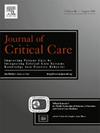评估严重社区获得性肺炎(sCAP)结果的风险调整住院时间:对16,985例ICU入院患者的机器学习分析
IF 2.9
3区 医学
Q2 CRITICAL CARE MEDICINE
引用次数: 0
摘要
背景:严重社区获得性肺炎(sCAP)使ICU资源紧张,需要有效的分配和稳健的基于价值的护理绩效指标。目前的ICU评估方法往往缺乏必要的细节和风险调整,无法进行有效的资源管理,特别是对于复杂的患者群体,如sCAP患者。本研究调查了基于机器学习的标准化住院时间比率(SLOSR)是否能够可靠地测量sCAP患者的风险调整后的LOS,从而实现基准测试。SLOSR的计算方法是观察到的住院时间(LOS)之和除以预测的住院时间(LOS)之和,从而使ICU能够对资源使用进行基准测试。研究设计和方法我们对巴西57家医院(2023年1月至12月)220个icu的16,985名成人sCAP患者进行了一项多中心回顾性队列研究。数据包括人口统计学、合并症、SAPS 3和呼吸支持。机器学习模型预测LOS并计算slsr。严格的验证包括交叉验证、校准图、漏斗图分析、RMSE、MAE和R2。结果住院死亡率为9.3%,ICU死亡率为6.4%,ICU平均住院时间为4天,平均SAPS 3评分为50分;28.1%接受了呼吸支持。slsr显示出稳健的组R2为0.89。模型的RMSE = 4.57, MAE = 3.10,校正效果良好。漏斗图分析显示,中位SLOSR为1.13 (Q1 = 0.9;Q3 = 1.34),强调了其作为基准的潜力。结论在巴西icu环境下,slosr有望作为评估sCAP患者调整后LOS的替代资源使用的工具。需要进一步的研究来验证其在其他环境中的性能。本文章由计算机程序翻译,如有差异,请以英文原文为准。
A risk-adjusted length of stay to evaluate severe Community-Acquired Pneumonia (sCAP) outcomes: A machine learning analysis of 16,985 ICU admissions
Background
Severe community-acquired pneumonia (sCAP) strains ICU resources, demands efficient allocation and robust performance metrics for value-based care. Current ICU assessment methods often lack the necessary detail and risk adjustment for effective resource management, especially for complex patient populations such as those with sCAP.
Research question
This study investigated whether the machine learning-based Standardized Length of Stay Ratio (SLOSR) could reliably measure risk-adjusted LOS for sCAP patients, enabling benchmarking. SLOSR is calculated as the sum of observed length of stay (LOS) divided by the sum of predicted LOS, enabling ICU benchmarking for resource use.
Study design and methods
We conducted a multicenter retrospective cohort study of 16,985 adult sCAP admissions across 220 ICUs in 57 Brazilian hospitals (January–December 2023). Data included demographics, comorbidities, SAPS 3, and ventilatory support. The machine learning model predicted LOS and calculated SLOSR. Rigorous validation included cross-validation, calibration plots, funnel plot analysis, RMSE, MAE, and R2.
Results
Hospital mortality was 9.3 %, ICU mortality 6.4 %, median ICU LOS 4 days, mean SAPS 3 score 50; 28.1 % received ventilatory support. The SLOSR demonstrated a robust grouped R2 of 0.89. The model achieved RMSE = 4.57 and MAE = 3.10, with excellent calibration. Funnel plot analysis revealed a median SLOSR of 1.13 (Q1 = 0.9; Q3 = 1.34), underscoring its potential for benchmarking.
Conclusion
SLOSR shows promise as tool for assessing adjusted LOS as a surrogate of resource use in sCAP patients in the context of Brazilian ICUs. Further research is needed to validate its performance in other settings.
求助全文
通过发布文献求助,成功后即可免费获取论文全文。
去求助
来源期刊

Journal of critical care
医学-危重病医学
CiteScore
8.60
自引率
2.70%
发文量
237
审稿时长
23 days
期刊介绍:
The Journal of Critical Care, the official publication of the World Federation of Societies of Intensive and Critical Care Medicine (WFSICCM), is a leading international, peer-reviewed journal providing original research, review articles, tutorials, and invited articles for physicians and allied health professionals involved in treating the critically ill. The Journal aims to improve patient care by furthering understanding of health systems research and its integration into clinical practice.
The Journal will include articles which discuss:
All aspects of health services research in critical care
System based practice in anesthesiology, perioperative and critical care medicine
The interface between anesthesiology, critical care medicine and pain
Integrating intraoperative management in preparation for postoperative critical care management and recovery
Optimizing patient management, i.e., exploring the interface between evidence-based principles or clinical insight into management and care of complex patients
The team approach in the OR and ICU
System-based research
Medical ethics
Technology in medicine
Seminars discussing current, state of the art, and sometimes controversial topics in anesthesiology, critical care medicine, and professional education
Residency Education.
 求助内容:
求助内容: 应助结果提醒方式:
应助结果提醒方式:


